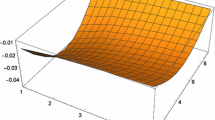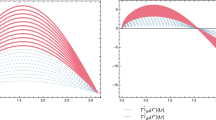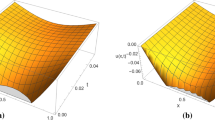Abstract
Fuzzy fractional partial differential equations are a generalization of classical fuzzy partial differential equation which can, in certain circumstances, provide a better explanation for certain phenomena. In this paper, a compact Crank–Nicholson scheme is developed, analyzed and applied to solve the fuzzy time diffusion equation with fractional order \(0 < \alpha \le 1\). It is based on double parametric form of fuzzy numbers and the time fractional derivative is defined using the Caputo definition. The truncation error and stability of the proposed scheme is discussed. The compact Crank–Nicholson scheme is shown to be a feasible scheme via a numerical example.




Similar content being viewed by others
References
Bakalis E, Zerbetto F (2016) Time fractional diffusion equations and analytical solvable models. In: Journal of Physics: Conference Series (vol. 738, No. 1, p. 012106). IOP Publishing
Al-Smadi M, Arqub OA (2019) Computational algorithm for solving Fredholm time-fractional partial integrodifferential equations of Dirichlet functions type with error estimates. Appl Math Comput 342:280–294
Çetinkaya A, Kıymaz O (2013) The solution of the time-fractional diffusion equation by the generalized differential transform method. Math Comput Model 57(9–10):2349–2354
Al-Smadi M (2018) Simplified iterative reproducing kernel method for handling time-fractional BVPs with error estimation. Ain Shams Eng J 9(4):2517–2525
Arqub OA, Al-Smadi M (2018) Atangana–Baleanu fractional approach to the solutions of Bagley–Torvik and Painlevé equations in Hilbert space. Chaos, Solitons Fractals 117:161–167
Al-Smadi M, Freihat A, Khalil H, Momani S, Ali Khan R (2017) Numerical multistep approach for solving fractional partial differential equations. Int J Comput Methods 14(03):1750029
Das S (2009) Analytical solution of a fractional diffusion equation by variational iteration method. Comput Math Appl 57(3):483–487
Ghazanfari B, Ebrahimi P (2015) Differential transformation method for solving fuzzy fractional heat equations. Int J Math Model Comput 5(1):81–89
Podlubny I (1998) Fractional differential equations: an introduction to fractional derivatives, fractional differential equations, to methods of their solution and some of their applications (vol 198). Elsevier, Amsterdam
Lin Y, Xu C (2007) Finite difference/spectral approximations for the time-fractional diffusion equation. J Comput Phys 225(2):1533–1552
Ma Y (2014) Two implicit finite difference methods for time fractional diffusion equation with source term. J Appl Math Bioinform 4(2):125–145
Cui M (2009) Compact finite difference method for the fractional diffusion equation. J Comput Phys 228(20):7792–7804
Gao GH, Sun ZZ (2011) A compact finite difference scheme for the fractional sub-diffusion equations. J Comput Phys 230(3):586–595
Karatay I, Bayramoglu SR (2014) High-order compact difference scheme for the numerical solution of time fractional heat equations. Sci World J. https://doi.org/10.1155/2014/642989
Al-Shibani FS, Ismail AIM, Abdullah FA (2013) Compact finite difference methods for the solution of one dimensional anomalous sub-diffusion equation. G E N 18(2):104–119
Ghazanfari B, Ebrahimi P (2015) Differential transformation method for solving fuzzy fractional heat equations. Int J Math Model Comput 5(1):81–89
Salah A, Khan M, Gondal MA (2013) A novel solution procedure for fuzzy fractional heat equations by homotopy analysis transform method. Neural Comput Appl 23(2):269–271
Chakraverty S, Tapaswini S (2014) Non-probabilistic solutions of imprecisely defined fractional-order diffusion equations. Chin Phys B 23(12):120–202
Zureigat H, Ismail AI, Sathasivam S (2018) Numerical solutions of fuzzy fractional diffusion equations by an implicit finite difference scheme. Neural Comput Appl. https://doi.org/10.1007/s00521-017-3299-7
Karatay İ, Bayramoğlu ŞR, Şahin A (2011) Implicit difference approximation for the time fractional heat equation with the nonlocal condition. Appl Numer Math 61(12):1281–1288
Yuste SB (2006) Weighted average finite difference methods for fractional diffusion equations. J Comput Phys 216(1):264–274
Ding HF, Zhang YX (2011) Notes on Implicit finite difference approximation for time fractional diffusion equations [Comput. Math. Appl. 56 (2008) 1138–1145]. Comput Math Appl 61(9):2924–2928
Liu F, Zhuang P, Anh V, Turner I, Burrage K (2007) Stability and convergence of the difference methods for the space–time fractional advection–diffusion equation. Appl Math Comput 191(1):12–20
Arqub OA, Mohammed AS, Momani S, Hayat T (2016) Numerical solutions of fuzzy differential equations using reproducing kernel Hilbert space method. Soft Comput 20(8):3283–3302
Arqub OA, Al-Smadi M, Momani S, Hayat T (2017) Application of reproducing kernel algorithm for solving second-order, two-point fuzzy boundary value problems. Soft Comput 21(23):7191–7206
Author information
Authors and Affiliations
Corresponding author
Ethics declarations
Conflict of interest
All authors declare they have no conflict of interest.
Additional information
Publisher's Note
Springer Nature remains neutral with regard to jurisdictional claims in published maps and institutional affiliations.
Rights and permissions
About this article
Cite this article
Zureigat, H., Ismail, A.I. & Sathasivam, S. A compact Crank–Nicholson scheme for the numerical solution of fuzzy time fractional diffusion equations. Neural Comput & Applic 32, 6405–6412 (2020). https://doi.org/10.1007/s00521-019-04148-2
Received:
Accepted:
Published:
Issue Date:
DOI: https://doi.org/10.1007/s00521-019-04148-2




